
For every kind of leather product out there, there’s now a vegan leather version of it with Tesla being one of the first manufacturers highlighting a sustainable option for leather seats. Here’s the thing, though — caring for vegan leather is a little different than caring for real leather. That’s why it’s crucial to know how to care for vegan leather to avoid permanent staining, color fading, and any other sort of deterioration.
As detailing shop owners, we’ve seen our fair share of vegan leather interiors, and we’ve learned a thing or two about caring for vegan leather over the years. In this article, Kevin Podas over at Dr. Beasley's will tell you everything they have learned about how to clean, condition and maintain your vegan leather so you can keep it looking and feeling great for as long as possible.
Why Does Vegan Leather Need Special Care?
While vegan leather or fake leather is similar to real leather in appearance, it requires special care due to its differences in structure.
- Vegan leather is less durable than real leather. The material is thinner and tends to deteriorate more easily, so it’s important to use gentle, non-caustic cleaners.
- Vegan leather is less absorbent than real leather. It’s less porous, so it doesn’t absorb conditioners in quite the same way and is more prone to drying out.
- Vegan leather is less flexible than real leather. It’s often more rigid than real leather, making proper conditioning even more crucial.
Knowing this, you’ll want to be sure you’re using the right products when cleaning and conditioning your vegan leather to make sure it will stay durable, vibrant and pliable in the long term.

What To Clean Vegan Leather With
Luckily, there are now dedicated products that are specifically engineered and designed for cleaning vegan leather. Using a Vegan Leather Cleanser ensures that formulas and ratios are professionally tested and approved to work properly without damaging the material in the process.
If absolutely needed, you can still make your own cleaning solutions by mixing water with household ingredients and applying them with a microfibre cloth, but we wouldn’t necessarily recommend it, as these solutions won’t be nearly as effective as a dedicated cleaner for vegan leather.
What About Home Cleaning Remedies?
As we mentioned earlier, vegan leather is less durable than real leather. Before there was a dedicated alternative on the market, people turned to using household remedies and all-purpose solutions, but they each have their own unique drawbacks.
- Disinfectant Wipes - Cleaning wipes by brands like Lysol and Clorox are often recommended for cleaning leather because most people have them on hand and they’re convenient. But they also contain alcohol, which is a desiccant, meaning that it will naturally dry out surfaces it comes into contact with. As we’ve mentioned, Vegan Leather is already susceptible to drying out so you need something that won’t exacerbate the issue.
- Dish Soap - Different brands of dish soaps contain added benefits that are helpful for other kinds of cleaning, but can actually be detrimental when used to clean vegan leather. Soap dyes cause discoloration, and scented dish soaps have been known to permanently alter the smell. They also run the risk of stripping away at the oils found in any kind of leather product.
- Vinegar - If you use the wrong type of vinegar, or mix it improperly, it can actually dry your vegan leather out when you try to clean it. This is due to the acidic properties present in most vinegars, which can be caustic to a material as sensitive as vegan leather.
- Baking Soda - This is one of the messier home alternatives that some people use to clean leather products. Baking soda is great for a lot of things, but it often leaves behind a chalky residue on the material’s surface. It can also react chemically to vegan leather, potentially dulling or darkening the surface.
When mixing and using any homemade remedy, there is of course some risk involved. Since they are not specifically formulated for the task at hand, and ratios when mixing may vary, outcomes can also differ.

How To Clean Vegan Leather
Before you start cleaning vegan leather, be sure the surface is clear so you’re not smearing around any dirt or grime as you apply. From there, follow these simple steps.
- Shake Vegan Leather Cleanser well to prevent solution from settling.
- Spray onto a small area from about 15 cm away.
- Wipe the surface clean with a dry microfibre cloth.
- Continue steps 2 and 3 as needed.
- Remove excess product with a clean microfibre towel.
Why You Should Condition Vegan Leather
Vegan leather needs to be conditioned just like real leather — even more so, considering its rigidity and poor absorption of moisture. Regular conditioning will help soften the stiff feel and prevent chipping, wrinkling, and cracking so as to extend its lifespan.
Without conditioning, you’re leaving your vegan leather open to abrasions from general wear and tear, as well as exposure to the elements, reducing its lifespan substantially. These concerns are typically unavoidable if you’re getting any normal usage out of your vegan leather product, so conditioning keeps them feeling fresh as new.
What To Condition Vegan Leather With
It’s best to use a dedicated Vegan Leather Cream when conditioning as vegan leather requires a special formulation to properly absorb the product due to its less porous nature. Otherwise, you risk the product lying dormant on the surface and unable to soak in, which causes an unsightly, greasy appearance.
If you’re in a pinch, other household alternatives can be used instead to condition vegan leather. They just won’t be as effective as a dedicated vegan leather cream.
Similar to cleaning vegan leather, there are household alternatives for conditioning vegan leather that some people have found to be effective. That being said, you’re still running the same risk where outcomes may vary based on specific brand and usage.
- Olive Oil - Using this alternative to condition vegan leather can actually accelerate the deterioration process by stiffening the material. In the short term, it can give a more supple and silkier texture, but it creates a coating that makes vegan leather even less porous than it already is. It’s also prone to discoloration, resulting in your vegan leather having a yellowish hue.
- Baby Oil - This doesn’t contain the same nutrients as a dedicated leather conditioner, so it doesn’t absorb well into any leather products, and that goes double for vegan leather. The result of this is a greasy residue that easily attracts dust and dirt.
- Coconut Oil - One of the biggest issues with coconut oil as a vegan leather conditioner is that it can be very sensitive to cold temperatures. If you live in a climate that experiences harsh winters, coconut oil can freeze to your vegan leather seats. It’s also been known to leave behind a distinct scent, and can even darken vegan leather when overused.
It’s best to use a product that is specifically formulated for conditioning vegan leather. That way, you have less to worry about when it comes to the lifespan and appearance of your faux leather products.

How To Condition Vegan Leather
Before you start conditioning vegan leather, be sure the surface is clean so you’re not smearing around any dirt or grime as you apply. From there, follow these simple steps.
- Shake Vegan Leather Cream well.
- Apply a thin coat of Vegan Leather Cream to a an applicator.
- Work in the product across the entire surface of your vegan leather.
- Let it sit for 10 to 15 minutes. Immediate results may look shiny or greasy at first, but if you’re using a dedicated vegan leather conditioner this will soon even out into a matte finish.
- After waiting, remove any excess product with a clean microfibre towel.
How To Care For And Maintain Vegan Leather
Caring for vegan leather is an ongoing process if you want it to last as long as possible. Here are some things to keep in mind when it comes to keeping a vegan leather care regimen:
- Handling - For vegan leather garments, you want to be sure you’re not abusing the material too harshly. Avoid overfilling or overusing the garment. With regards to car seats and furniture, it’s best to handle them with care when sitting on or getting off of them.
- Regular Cleaning - Regular cleaning will help prevent buildup of grime so cleaning is easier in the future and won’t require as much abrasion on the surface. Be sure never to use harsh, abrasive, alcoholic cleaners as they can dry out leather or even fade the color.
- Regular Conditioning - Conditioning helps to moisturise and prevent cracks and peels, greatly extending the lifetime of the material. It also makes leather less frictious, which helps avoid wear from everyday use.
- Applying Protection - Ceramic coating your vegan leather helps to prevent permanent stains and resist UV color fading. This will make cleaning vegan leather easier in the future and extend its lifespan.
There’s no denying vegan leather is a little different than real leather when it comes to care. That being said, as long as you’re following our best practices for cleaning, conditioning and protecting vegan leather, caring for this unique material is easy.


